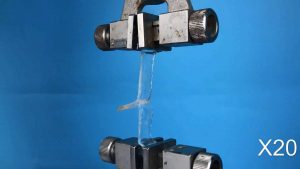“Nature is full of loopholes, waiting to be stitched,” says Zhigang Suo, Ph.D., a Harvard researcher who has helped develop a new kind of adhesive, one that uses molecular sutures to sew together various materials, including hydrogels, elastomers, and inorganic solids. Remarkably, these sutures can be undone easily, simply by exposing them to ultraviolet (UV) light.
The loophole to which Dr. Suo refers is a way of getting around the difficult and often painful peeling of strong adhesive bandages from living tissue, which is just another “inorganic solid.” By incorporating UV-sensitive molecular sutures, wound dressings, transdermal drug delivery patches, and wearable robotics could stay firmly attached—until they are exposed to UV light, at which point they may be easily and painlessly detached.
Dr. Suo, a professor of mechanics and materials at Harvard’s School of Engineering and Applied Sciences (SEAS), co-led a study with Kangling Wu, a researcher at Xi’an Jiaotong University in China. Together, they served as senior authors of a paper (“Photodetachable Adhesion”) that appeared in the journal Advanced Materials.
The paper describes how the new adhesive uses an aqueous solution of polymer chains spread between two, non-sticky materials—like jam between two slices of bread. On their own, the two materials adhere poorly together but the polymer chains act as a molecular suture, stitching the two materials together by forming a network with the two preexisting polymer networks. This process is known as topological entanglement.
When exposed to ultraviolet light, the network of stitches dissolves, separating the two materials.

“The principle of photodetachable adhesion is first demonstrated using two hydrogels as adherends,” the article detailed. “Each hydrogel has a covalent polymer network, but does not have functional groups for bonding, so that the two hydrogels by themselves adhere poorly.
“The two hydrogels, however, adhere strongly when an aqueous solution of polymer chains is spread on the surfaces of the hydrogels and is triggered to form a stitching polymer network in situ, in topological entanglement with the pre‐existing polymer networks of the two hydrogels. The two hydrogels detach easily when the stitching polymer network is so functionalized that it undergoes a gel–sol transition in response to a UV light.”
The researchers tested adhesion and detachment on a range of materials, sticking together hydrogels; hydrogels and organic tissue; elastomers; hydrogels and elastomers; and hydrogels and inorganic solids. “Our strategy works across a range of materials and may enable broad applications,” said Wu.
“Strong adhesion usually requires covalent bonds, physical interactions, or a combination of both,” added Yang Gao, first author of the paper and a researcher at Xi’an Jiaotong University. “Adhesion through covalent bonds is hard to remove and adhesion through physical interactions usually requires solvents, which can be time-consuming and environmentally harmful. Our method of using light to trigger detachment is noninvasive and painless.”
“In nature, wet materials don’t like to adhere together,” noted Dr. Suo. “We have discovered a general approach to overcome this challenge. Our molecular sutures can strongly adhere wet materials together. Furthermore, the strong adhesion can be made permanent, transient, or detachable on demand, in response to a cue.”
While the researchers focused on using UV light to trigger detachment, their work suggests the possibility that the stitching polymer could detach with near-infrared light, a feature which could be applied to a range of new medical procedures.


